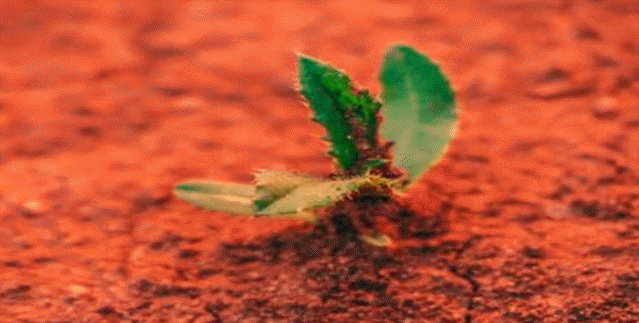
Growing plants on Mars presents a series of significant environmental challenges, from nutrient deficiencies to harsh soil conditions. Scientists and researchers are exploring innovative methods to make Martian regolith—soil—suitable for growing plant life. This article outlines the key strategies being researched and their potential for success.
1. Enhancing Soil Nutrients
Martian regolith lacks essential nutrients necessary for plant growth, such as nitrogen, phosphorus, and sulfur. To overcome this limitation, researchers are investigating various methods to enhance the nutrient content of the soil:
- Fertilizer Addition: By adding fertilizers, such as those derived from fly larvae (frass), experiments have shown that plant growth in simulated Martian soil can be significantly improved.
- Biofertilization: Alfalfa, known for its ability to thrive in extreme conditions, could be used as a natural fertilizer. It has the potential to enrich the soil by fixing nitrogen, which is essential for other crops like turnips, radishes, and lettuce.
2. Improving Soil Structure
The density and clay-like texture of Martian regolith can inhibit root growth. Therefore, it’s necessary to improve the soil structure to create a more conducive environment for plant life:
- Adding Organic Matter: By incorporating organic materials such as compost or even earthworm castings, Martian regolith can be made more porous, improving water retention and root penetration.
- Soil Mixing: A combination of Martian regolith and small amounts of Earth soil or other organic materials can loosen the regolith, facilitating better plant root development.
3. Managing Water on Mars
Water is a critical resource for plant growth on Mars, but the planet’s low atmospheric pressure and frigid temperatures make water management a significant challenge. Some strategies being explored include:
- Hydroponics and Greenhouses: Controlled environments, like greenhouses, could provide the necessary moisture and temperature for plant growth, while shielding plants from Mars’ extreme conditions.
- Water Recycling Systems: Due to Mars’ limited water resources, water recycling technologies could be implemented to ensure efficient water use for plant cultivation.
4. Neutralizing Toxic Compounds
Martian soil contains perchlorates, which are toxic to most Earth plants. To make the soil suitable for growing crops, it is essential to neutralize or remove these harmful compounds:
- Rinsing the Soil: One potential solution is to rinse Martian regolith with water to remove the perchlorates.
- Bioremediation: Another approach involves using specialized bacteria that can consume and break down perchlorates, making the soil safe for plant growth.
5. Creating Controlled Environments
Due to Mars’ hostile environment—low pressure, extreme temperatures, and high radiation—plants will need an artificial environment to grow. Some possible solutions include:
- Greenhouses with Regulated Conditions: Greenhouses on Mars could regulate temperature, humidity, and light to protect plants from the planet’s harsh conditions, ensuring a stable growing environment.
6. Using Microbial Helpers
Microbial life plays a crucial role in soil health by aiding in nutrient cycling and supporting plant growth. On Mars, introducing beneficial microbes could help in several ways:
- Nitrogen Fixation: Mars’ atmosphere contains nitrogen, but it’s not in a form usable by plants. Introducing nitrogen-fixing bacteria can convert atmospheric nitrogen into a form that plants can use, ensuring a steady nitrogen supply for crops.
7. Genetic Engineering for Martian Crops
One of the most long-term strategies for cultivating plants on Mars involves genetic engineering. By incorporating traits from Earth’s extremophiles (organisms that thrive in extreme environments), scientists could create crops that can survive Mars’ harsh conditions:
- Tailored Plant Traits: Genetically modified plants could be designed to tolerate the extreme cold, low light levels, and high UV radiation found on Mars.
Challenges Remain, But Hope Endures
While these strategies show promise, they are still largely theoretical or in the experimental phase. The success of these methods depends on a variety of factors, including the exact conditions of Martian soil and the technological advancements available for future Martian explorers. Nonetheless, these innovations offer hope that one day, Mars could become a fertile ground for agriculture, potentially supporting long-term human missions or even permanent settlements on the Red Planet.
Get ready for out-of-this-world fun with the UFO Cow Abduction: Beam Up Your Bovine, the hilarious and quirky game that lets you “beam up” cows in your own UFO! With over 6,809 ratings and a 4.5-star average, it’s clear that players are loving the fun and challenge this game brings.
A hit with over 5,000 units sold just last month, you can grab your own copy for only $11.39 on Amazon! Whether you’re looking to add a little whimsy to your gaming collection or want a great gift for friends and family, this game delivers non-stop fun. Order now for just $11.39 at Amazon!
Support Techcratic
If you find value in Techcratic’s insights and articles, consider supporting us with Bitcoin. Your support helps me, as a solo operator, continue delivering high-quality content while managing all the technical aspects, from server maintenance to blog writing, future updates, and improvements. Support Innovation! Thank you.
Bitcoin Address:
bc1qlszw7elx2qahjwvaryh0tkgg8y68enw30gpvge
Please verify this address before sending funds.
Bitcoin QR Code
Simply scan the QR code below to support Techcratic.

Please read the Privacy and Security Disclaimer on how Techcratic handles your support.
Disclaimer: As an Amazon Associate, Techcratic may earn from qualifying purchases.














![Massive Apple deal event – M3 iPad Air all-time low, AirPods, M4 MacBooks $300 off, more [Updated]](https://techcratic.com/wp-content/uploads/2025/08/AirPods-Pro-2-AirPods-4-360x180.jpg)


























































![BASENOR 3PCS Tesla Model Y Model 3 Center Console Organizer [Carbon Fiber Edition]…](https://techcratic.com/wp-content/uploads/2025/08/71R5dfCR9FL._AC_SL1500_-360x180.jpg)















![Alien: Romulus – 4K + Blu-ray + Digital [4K UHD]](https://techcratic.com/wp-content/uploads/2025/08/81fBb0Z1egL._SL1500_-360x180.jpg)









